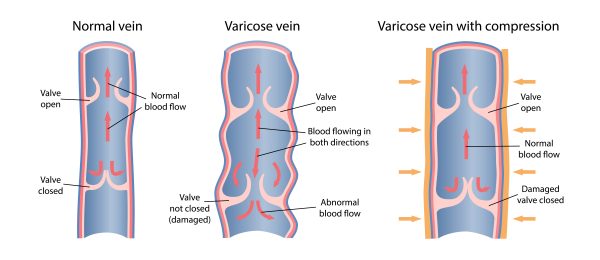There are many contributing factors to foot and leg pain. Some are quite innocuous; such as aching muscles after an intense leg workout or sore feet from hours of walking or standing. However, some could be serious and may be linked to an underlying issue like varicose veins. So when it comes to the causes of foot and leg pain, it’s important to know when to see your doctor.
Foot and leg pain can originate in the bones, joints, muscles, tendons, ligaments, blood vessels, nerves, and even skin. It can be experienced in the feet, ankles, knees, thighs, back of the legs, and generally in any part of the leg.
However, severe or sudden pain, burning, numbness or discomfort in the lower extremities can mean something more serious is going on. In fact, you need to go to a medical professional for severe pain that doesn’t resolve within a few minutes.
Vein pain in leg and foot: Some possible causes
- Blood vessel disorders – conditions such as varicose veins, spider veins and DVT (deep vein thrombosis) can cause severe leg pain, especially after a lengthy car ride or flight.
- PAD (peripheral artery disease) – a narrowing of the arteries that carry blood to your feet and legs, typically caused by the buildup of plaque or fatty deposits.
- Electrolyte Imbalance – healthy muscle function requires a well-balanced mix of electrolytes, such as sodium, potassium, calcium and magnesium. When electrolyte levels fall below normal, it can cause leg pain and cramping.
- Peripheral neuropathy – foot and leg pain that results when the nerves that transmit messages between the brain and spinal cord and the rest of the body (including your internal organs) are damaged or diseased. This condition is most commonly associated with alcoholism and diabetes.
- Back problems – conditions such as spinal stenosis and sciatica can affect the nerves, causing pain to travel from your lower back, down your legs, all the way to your feet.
- Arthritis – osteoarthritis and rheumatoid arthritis cause inflammation in the cartilage, bones and joints, contributing to pain in legs, feet, and even the surrounding muscles.
How to deal with foot and leg pain due to blood vessel disorders
If you’ve been diagnosed with DVT, your doctor will have two primary objectives. One is to prevent the blood clot from getting larger. The other is to make sure the clot doesn’t end up in your lungs. Because if a clot does end up in the lungs, it can cause a life-threatening pulmonary embolism. Fortunately, specialists can generally manage blood clots with blood thinners and clot-buster medications.
Painful feet and legs due to the presence of varicose veins
Although not life-threatening in most cases, varicose veins can cause pain and discomfort in your lower extremities. Treating the diseased veins will often alleviate the source of the pain and give you an improved quality of life.
Based on the severity of the disease, your phlebologist (vein specialist) may recommend a number of non-surgical treatment options. These include Sclerotherapy, Endovenous Laser Therapy (EVLA) and Radiofrequency Ablation (RFA) or VenaSeal vein glue.
It’s possible that your doctor may diagnose your varicose veins as being mild. This means that they don’t require treatment even though they may be causing your feet and legs to become swollen, ache or burn on occasion. They may recommend natural methods to manage your condition.
The best ways to improve your circulatory system naturally
- Nutrition and supplements. Studies show that adding folic acid, flavonoids and grape-seed extract to your diet can improve blood circulation while minimising water retention and bloating. Read more: non-surgical options for managing varicose veins.
- Get more active. In particular, doing moderate exercise every day, such as yoga, swimming, hiking, walking your dog or riding a bike can positively affect your circulatory system.
- Avoid wearing tight clothing. Tight pants or high heels may be stylish, but they constrict your veins and are terrible for your circulation.
- Wear compression stockings. These are special garments that promote healthy blood flow by applying pressure on your veins, helping to alleviate swelling and inflammation. Compression stockings are available from Bauerfeind.
- Relax and put your feet up. Doing so has the dual benefit of calming you down and helping to prevent blood from pooling in your lower legs.
Seek expert advice
The doctors at The Vein Institute specialise in varicose vein treatment. We offer patients a comprehensive program using non-surgical laser treatment techniques.
The benefits of non-surgical varicose vein treatment are:
- Walk-in walk-out treatment
- 98% success rate
- Extremely effective
- Can be performed at a clinic (no hospitalisation)
- No general anaesthetic
- Medicare rebates apply
- No downtime or time away from work
Call us on 0420 102 637, or fill out our booking request form.
See more vein facts: Answering Your Vein FAQs
Recent Posts



